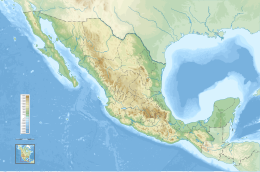
Back جغرافيا المكسيك Arabic Xeografía de Méxicu AST Геаграфія Мексікі Byelorussian География на Мексико Bulgarian মেক্সিকোর ভূগোল Bengali/Bangla Douaroniezh Mec'hiko Breton Geografia física de Mèxic Catalan Daearyddiaeth Mecsico Welsh Mexicos geografi Danish Geografía de México Spanish
 | |
| Continent | North America |
|---|---|
| Coordinates | 23°00′N 102°00′W / 23.000°N 102.000°W |
| Area | |
| • Total | 1,972,550 km2 (761,610 sq mi) |
| • Land | 98.96% |
| • Water | 1.04% |
| Coastline | 9,330 km (5,800 mi) |
| Borders | Total land borders 4,263 km |
| Highest point | Pico de Orizaba volcano 5,700 m |
| Lowest point | Laguna Salada -10 m |
| Longest river | Rio Grande 3,108 km |
| Largest lake | Lake Chapala 1,100 km2 (420 sq mi) |
| Exclusive economic zone | 3,269,386 km2 (1,262,317 sq mi) |
The geography of Mexico describes the geographic features of Mexico, a country in the Americas. Mexico is located at about 23° N and 102° W[1] in the southern portion of North America.[2][3] From its farthest land points, Mexico is a little over 3,200 km (2,000 mi) in length. Mexico is bounded to the north by the United States (specifically, from west to east, by California, Arizona, New Mexico, and Texas), to the west and south by the Pacific Ocean, to the east by the Gulf of Mexico, and to the southeast by Belize, Guatemala, and the Caribbean Sea. The northernmost constituent of Latin America, it is the most populous Spanish-speaking country in the world. Mexico is the world's 13th largest country, three times the size of Texas.[4]
Almost all of Mexico is on the North American Plate, with small parts of the Baja California Peninsula in the northwest on the Pacific and Cocos Plates. Some geographers include the portion east of the Isthmus of Tehuantepec including the Yucatán Peninsula within North America. This portion includes Campeche, Chiapas, Tabasco, Quintana Roo, and Yucatán, representing 12.1 percent of the country's total area. Alternatively, the Trans-Mexican Volcanic Belt may be said to delimit the region physiographically on the north.[5] Geopolitically, Mexico is generally not considered part of Central America. Politically, Mexico is divided into thirty-two states.
As well as numerous neighbouring islands, Mexican territory includes the more remote Isla Guadalupe and the Islas Revillagigedo in the Pacific. Mexico's total area covers 1,972,550 square kilometers, including approximately 6,000 square kilometers of islands in the Pacific Ocean, Gulf of Mexico, Caribbean Sea, and Gulf of California. On its north, Mexico shares a 5,000-kilometer border with the United States. The meandering Río Bravo del Norte (known as the Rio Grande in the United States) defines the border from Ciudad Juárez east to the Gulf of Mexico. A series of natural and artificial markers delineate the United States-Mexican border west from Ciudad Juárez to the Pacific Ocean. The Mexico-U.S. boundary is jointly administered by the International Boundary and Water Commission.[6] On its south, Mexico shares an 871 kilometer border with Guatemala and a 251-kilometer border with Belize.
Mexico has a 9,330-kilometer coastline, of which 7,338 kilometers face the Pacific Ocean and the Gulf of California, and the remaining 2,805 kilometers front the Gulf of Mexico and the Caribbean Sea. Mexico's exclusive economic zone (EEZ) covers 3,269,386 km2 (1,262,317 sq mi) and is the 13th largest in the world. It extends 200 mi (320 km) nautical miles off each coast. The landmass of Mexico dramatically narrows as it moves in a southeasterly direction from the United States border and then abruptly curves northward before ending in the 500-kilometer-long Yucatán Peninsula. Indeed, the state capital of Yucatán, Mérida, is farther north than Mexico City or Guadalajara.
- ^ Francaviglia, Richard V. "Geography and climate", U.S. Mexican War, 1846–1848. March 14, 2006: PBS / KERA
- ^ Mexico The American Heritage Reference Collection Archived 2007-02-24 at the Wayback Machine, et al.
- ^ Mexico Archived 2007-06-20 at the Wayback Machine The Columbia Encyclopedia Archived February 2, 2007, at the Wayback Machine
- ^ "Mexico Country Specific Information Archived December 16, 2010, at the Wayback Machine." United States Department of State. Retrieved on March 22, 2012.
- ^ Nord-Amèrica, in Gran Enciclopèdia Catalana
- ^ Robert J. McCarthy, Executive Authority, Adaptive Treaty Interpretation, and the International Boundary and Water Commission, U.S.-Mexico, 14-2 U. Denv. Water L. Rev. 197(Spring 2011) (also available for free download at https://ssrn.com/abstract=1839903).
© MMXXIII Rich X Search. We shall prevail. All rights reserved. Rich X Search